You'll need several essential tools to create your own perfume at home. Start with precise measuring equipment like digital scales (0.01g precision), glass beakers, and droppers for accurate ingredient portions. Don't forget protective gear including nitrile gloves, safety goggles, and a lab coat. Stock up on glass storage containers, stainless steel funnels, and proper documentation materials for recording your formulas. The right equipment can transform your perfume-making journey from basic mixing to professional-level crafting.
Essential Measuring and Weighing Equipment
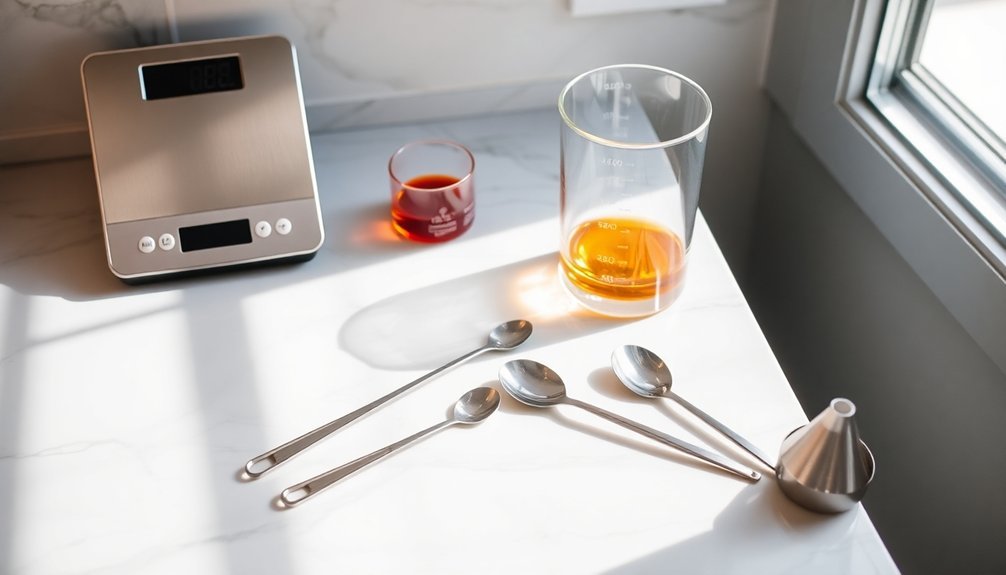
Four essential measuring tools form the foundation of perfume making: digital scales, glass equipment, thermometers, and specialized tools like pipettes and droppers.
You'll need a digital scale that measures up to 200 grams with 0.01-gram precision for accurate ingredient portions. Mini digital scales at US$29.95 offer a cost-effective starting point for beginners. The scale's tare function lets you zero out container weights, while multiple unit settings help you work with various measurements.
Your glass equipment should include measuring cylinders, beakers, and flasks made from borosilicate glass. You'll sterilize these with ethanol before use.
Thermometers are vital when you're heating ingredients to specific temperatures, working alongside your glass equipment to maintain consistency.
Don't forget disposable pipettes and Monprene droppers for precise liquid measurements, plus stainless steel funnels and spatulas for handling materials.
Filter paper helps you strain tinctures effectively.
Safe Handling and Transfer Tools
When working with fragrant oils and chemicals, proper safety equipment and handling tools are essential for protecting yourself and your workspace.
You'll need stainless steel trays to catch spills and protect surfaces while you're pouring or filling bottles. Stainless steel funnels are important for transferring liquids safely and precisely without splashing or wastage.
For mixing and holding your fragrant substances, use borosilicate beakers that can withstand various chemicals and temperatures. Always wear protective nitrile gloves when handling any chemicals or fragrant materials.
Graduated cylinders will help you measure liquids accurately during transfers, while droppers allow for precise handling of small quantities of fragrance oils.
These tools aren't just about convenience – they're significant for maintaining a safe working environment and ensuring you can handle delicate materials without risking contamination or accidents.
Glass Storage Solutions and Packaging Materials
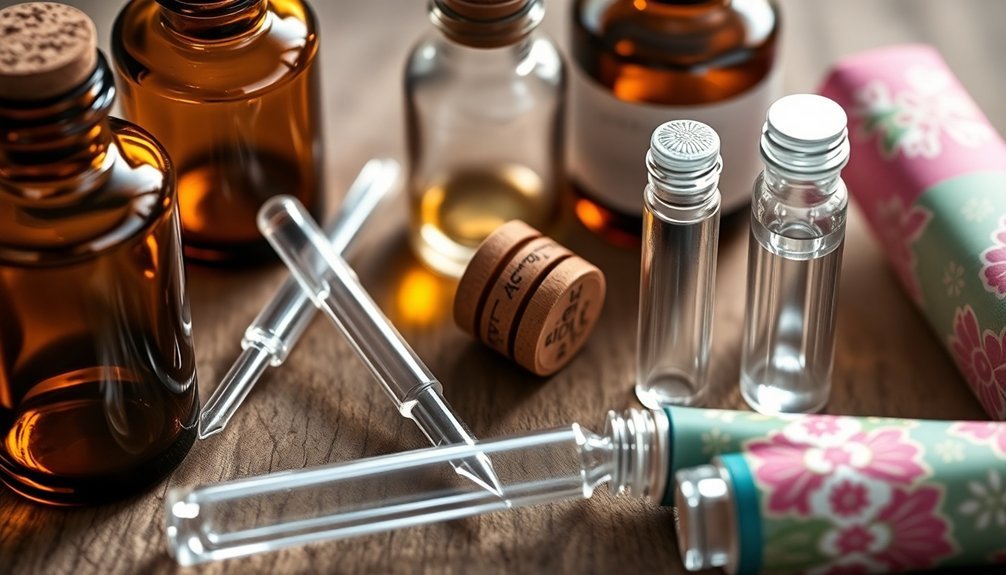
Proper storage is critical for maintaining the quality and longevity of your perfumes and essential oils.
You'll need glass containers and storage solutions that protect your creations from light, heat, and moisture damage. Consider using glass display cases or perfume drawers with proper inserts to keep your bottles organized and protected. Implementing a FIFO system helps track inventory effectively and ensures proper product rotation.
For packaging and transportation, you'll want bubble wrap, foam, or corrugated materials to cushion your bottles. Use cardboard boxes or plastic bins with ice packs to maintain cool temperatures during transit.
Don't forget to wrap the bottle mouths carefully to prevent leakage. For an elegant presentation, try wall-mounted acrylic shelves or wooden trays.
Keep your storage area cool, dark, and moisture-free, away from bathrooms or areas with temperature fluctuations. Always store bottles in a single layer to prevent breakage.
Protective Gear and Safety Essentials
Working with concentrated perfume oils and chemicals requires extensive safety equipment to protect yourself from potential hazards.
You'll need a lab coat or protective garment along with a plastic apron to prevent skin contact. Always wear nitrile gloves for ideal chemical resistance, and don't rely on standard household rubber gloves.
For eye protection, use safety goggles or spectacles to guard against splashes. Keep an eye wash station nearby, and if you wear contact lenses, be prepared to remove them quickly if needed.
Your workspace must be well-ventilated to prevent vapor inhalation, and keep it clear of heat sources and ignition points.
Remember to wash your hands thoroughly after handling materials, even when wearing gloves, and never take contaminated clothing outside your work area.
Testing Equipment for Scent Development
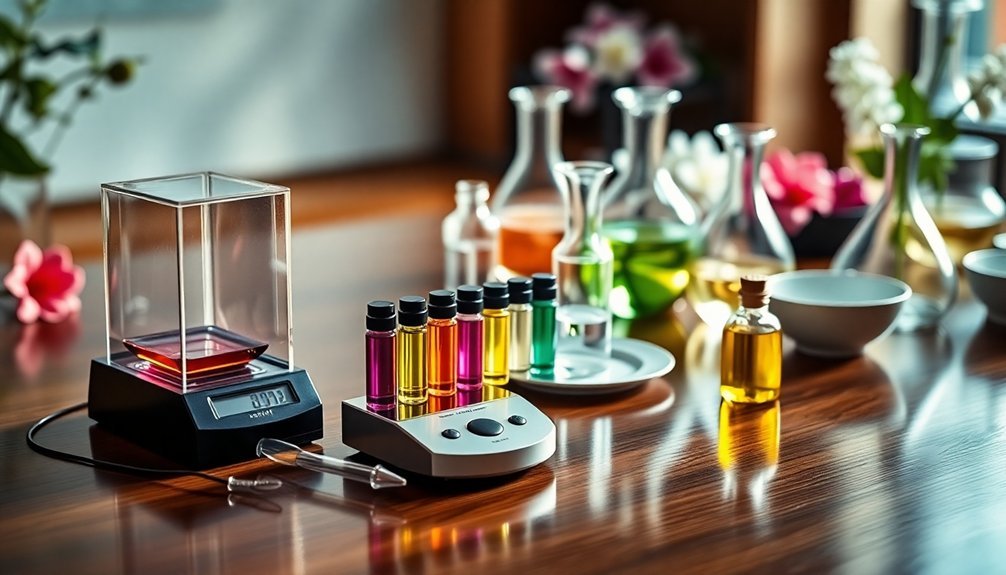
Professional perfume development relies heavily on sophisticated analytical equipment to guarantee precise scent creation and quality control.
You'll need essential tools like gas chromatography mass spectrometry (GC/MS) to analyze and identify specific compounds in your fragrances. This technology works alongside headspace analysis and FTIR spectroscopy for thorough scent evaluation.
For extraction, you'll require specialized equipment including extractors, tubular heaters, evaporators, and oil-liquid separators.
Don't forget the essential vacuum pump and foam breaker to guarantee clean extraction processes. Modern e-tongue devices with sensor lipid membranes can help you assess and classify your perfume components accurately.
For daily testing, keep testing strips handy – they provide a neutral surface for evaluating your scents without interference from body chemistry or temperature variations.
Basic Laboratory Supplies for Fragrance Creation
You'll need precise measuring tools like digital scales (accurate to 0.01g) and graduated cylinders to create consistent, high-quality fragrances.
Your essential equipment should include glass beakers ranging from 15ml to 50ml, along with measuring spoons and droppers for accurate ingredient portions.
For proper storage of your materials and finished perfumes, stock up on dark glass containers with secure caps, making sure to label everything clearly with waterproof tags.
Essential Measuring Equipment
Creating perfumes requires several essential measuring tools to guarantee precision and consistency in your formulations.
You'll need glass measuring cylinders and graduated cylinders for accurate liquid measurements, along with borosilicate beakers for handling various solvents and dilutions.
For weighing ingredients, you'll want a digital scale with 0.01g readability that can measure up to 200 grams or more.
Don't forget to include thermometers when working with temperature-sensitive recipes.
To handle and transfer your ingredients safely, you'll need disposable plastic pipettes and Monprene droppers that resist solvents.
A mixer with Teflon bars will help you blend thick aromatics effectively.
For filtration, make sure you have stainless steel strainers, filter papers, and a separatory funnel to process your mixtures properly.
Storage Solutions For Ingredients
Proper storage of perfume ingredients is just as important as measuring them accurately. You'll need clear 1 oz glass bottles with polypropylene lined caps to protect your fragrances from contamination and light exposure.
Store your ingredients in a cool, dark place away from sunlight and humidity – a closet or drawer is ideal.
Keep your supplies organized and protected with these essential storage practices:
- Use borosilicate glass bottles for durability and wrap them in aluminum foil to block light
- Label each container clearly with contents and date to track your ingredients
- Store pipettes and fragrance strips in separate airtight containers to prevent cross-contamination
Maintain a consistent temperature and avoid humid environments like bathrooms to preserve the quality of your ingredients.
You'll also want disposable gloves nearby for safe handling.
Precision Tools for Ingredient Handling
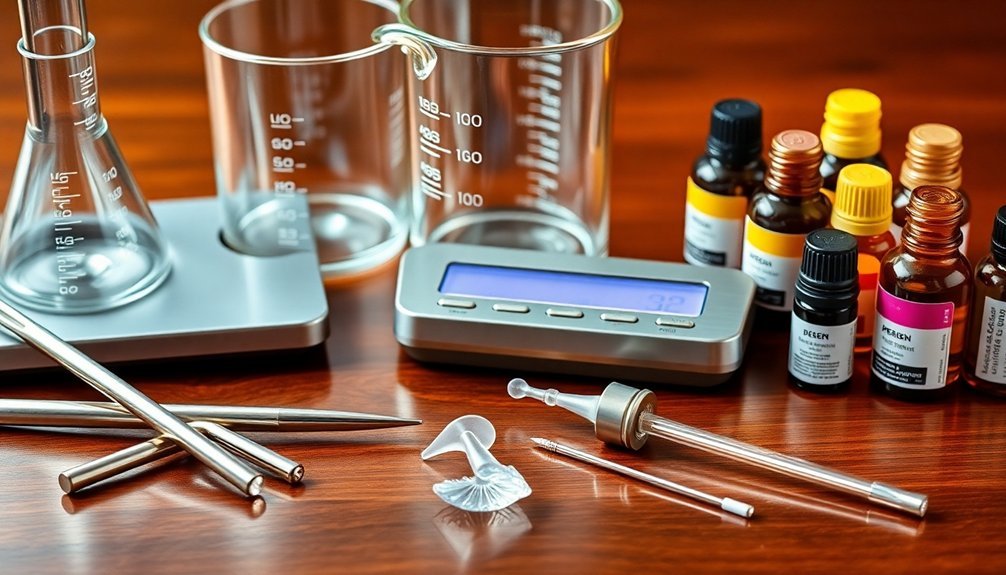
The art of perfume-making relies heavily on precise measurements and careful ingredient handling. You'll need several essential tools to guarantee accuracy in your perfume creation process.
Pipettes are vital for transferring small volumes of ingredients with precision, while droppers help you measure exact amounts of essential oils and fragrances. You'll want to keep your ingredients in dropper bottles for easy dispensing during the mixing process.
For larger quantities, graduated cylinders provide highly accurate measurements of your liquid components.
Don't forget to invest in high-quality stainless steel measuring cups and spoons for your dry ingredients. These tools will help you maintain consistency in your formulations and guarantee that each batch of perfume meets your exact specifications.
Organization and Documentation Equipment
You'll need robust record-keeping tools, including notebooks, digital spreadsheets, and filing systems, to track your perfume formulas and production details.
Digital organization systems like perfumery software and cloud storage help you maintain searchable databases of ingredients, formulations, and safety documentation.
Clear labeling methods and organized filing systems guarantee you can quickly access your formula sheets, batch records, and safety data sheets when needed.
Record-Keeping Essentials
Successful perfume-making relies heavily on meticulous record-keeping and organization.
You'll need an extensive system to track your formulations, experiments, and production details. Essential tools include archival storage for preserving your recipes, quality control records for maintaining consistency, and safety data sheets for handling materials properly.
To create an effective record-keeping system, you'll want:
- A dedicated perfumer's journal with acid-free pages to document your formulas, observations, and adjustments
- Small adhesive labels and waterproof markers to identify your ingredients, samples, and test batches
- Digital spreadsheets to manage inventory, track production schedules, and maintain version control of your formulations
Don't forget to maintain separate files for regulatory compliance, customer feedback, and certification documents to guarantee your perfume-making operation runs smoothly.
Digital Organization Systems
Modern perfumers rely heavily on digital organization systems to streamline their creative process and maintain precise documentation.
You'll find AI-powered tools like Philyra that can analyze thousands of ingredients and formulas, cutting development time from two years to just six months. These systems help you track and organize your formulations while suggesting innovative ingredient combinations.
To enhance your perfume creation process, you can utilize virtual scent mapping tools and digital scent wheels to navigate fragrance families.
Givaudan's Myrissi technology can translate your fragrances into color patterns, helping you create cohesive visual branding and packaging designs.
For customer engagement, you can implement AI-driven recommendation systems that match specific scent profiles to consumer preferences, making it easier to target your fragrances to the right audience.
Labeling and Filing Methods
Proper labeling and filing systems serve as the backbone of any perfume-making operation, ensuring both regulatory compliance and efficient organization.
You'll need reliable labeling equipment and materials that match your production scale, from manual applicators for small batches to automated machines for larger operations.
- High-quality label materials (paper, vinyl, or foil) with proper adhesives that won't peel under various environmental conditions
- Label makers or printers capable of producing clear, legible text for essential information like fragrance names, ingredients, and batch numbers
- Filing systems to track your perfume formulas, batch records, and regulatory documentation
Choose materials and methods that align with your production needs while meeting regional regulations like EU's REACH or FDA requirements.
If you're scaling up, consider investing in semi-automated or automated labeling equipment to maintain consistency and efficiency.
Filtering and Straining Apparatus
Professional perfume-making relies heavily on precise filtering and straining equipment to achieve pure, crystal-clear results.
You'll need a high-quality filtration system made of stainless steel with PES membrane pleated filters and a positive pressure pump. This setup helps you remove impurities from your natural and synthetic ingredients, essential oils, and aromatic compounds.
For basic straining, you'll want glass funnels, specialized filter papers, and clean beakers.
Don't use coffee filters or non-specialized materials, as they won't provide the purity your perfumes require. Your straining apparatus should be strictly glass to avoid contamination.
When filtering natural materials, you might need multiple passes to remove all particles and sediments.
Remember to maintain sanitary conditions throughout the process and allow sufficient time for thorough filtration.
Advanced Production and Bottling Tools
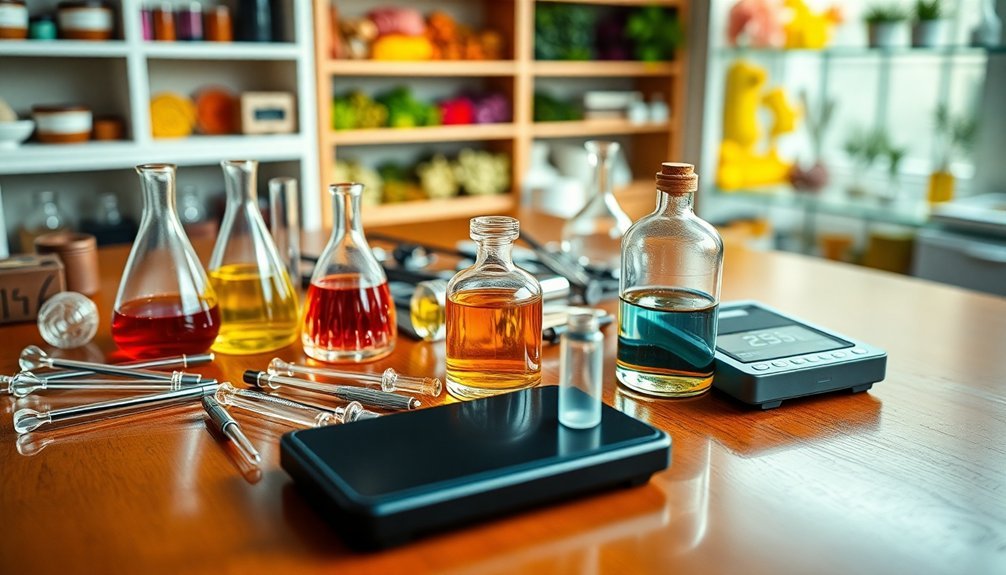
Your professional perfume production requires precision bottling equipment like pneumatic fillers and automated filling plants to guarantee consistent volumes across batches.
You'll need reliable crimping and sealing tools, including capping machines that create airtight closures to maintain fragrance integrity.
Quality control testing devices such as gas chromatographs and spectrophotometers help you monitor the chemical composition and stability of your finished products.
Precision Bottling Equipment Needs
Precise bottling equipment forms the backbone of successful perfume production, whether you're running a small artisanal operation or managing a large-scale facility.
You'll need filling machines that match your production scale, from simple bench-top fillers for small batches to fully automatic lines for high-volume operations.
For maximum precision in your bottling process, you'll want to take into account:
- An Omnispense filling machine for consistent, accurate dispensing with minimal maintenance needs
- A Perfumline 50 system if you're working with specialty closures like atomizers or micro-sprays
- Digital scales and measuring devices to guarantee exact quantities during the filling process
Don't overlook the importance of quality control equipment like density meters and pH meters to maintain consistency throughout your bottling operations.
Crimping and Sealing Essentials
After mastering the art of precise bottling, the next step in perfume production focuses on securing your valuable fragrances. You'll need specific crimping tools to guarantee your perfumes remain fresh and sealed.
For small-scale operations, you can opt for a hand-held crimping tool designed for 15mm pumps. This tool provides reliable, multi-tooth crimps that create tight seals.
If you're starting a small perfume business, consider using a collar fitting tool – it's a cost-effective alternative to expensive presses and works well with crimp-less pumps.
For larger operations, you'll want to invest in automated capping machines that deliver consistent, airtight seals.
When selecting your crimping equipment, prioritize suppliers with proven track records and positive user reviews. Choose tools that match your production scale and offer the best value for your investment.
Quality Control Testing Tools
To maintain the highest quality standards in perfume production, you'll need sophisticated testing equipment that analyzes every aspect of your fragrances.
Gas chromatographs with high-resolution columns detect impurities and verify marker compounds, while spectrophotometers measure color and absorption properties using minimal sample volumes.
You'll find multiparameter measurement systems particularly valuable, as they'll simultaneously test density, refractive index, and optical rotation while preserving your precious samples.
Essential quality control tools include:
- GC-FID analyzers with 150-250 μm columns and hydrogen carrier gas for precise fingerprint analysis
- Automated spectrophotometers that measure color, turbidity, and optical rotation in a single cycle
- Integrated testing stations that combine filling, rinsing, and drying functions while enabling sample recovery
Frequently Asked Questions
How Often Should Perfume-Making Tools Be Cleaned and Sanitized?
You'll need to clean your perfume-making tools after each use, with daily sanitization for items touching different fragrances. Use isopropyl alcohol or mild soap, and sterilize more frequently when working with hydrosols.
Can Regular Kitchen Equipment Substitute for Professional Perfume-Making Tools?
While you can use some kitchen equipment initially, it won't provide the precision and safety you need. Professional perfume-making tools offer better accuracy, reduce contamination risks, and guarantee consistent results in your creations.
What's the Average Cost to Acquire Basic Perfume-Making Equipment?
You'll need to invest around $300-500 for basic perfume-making equipment. This includes a reliable digital scale ($100), essential glassware ($100), pipettes ($50), and protective gear ($50-100) to get started.
Which Tools Are Absolutely Essential for Beginners Making Simple Perfumes?
You'll need measuring spoons, glass beakers, dark storage bottles, pipettes, and protective gloves as essential tools. Don't forget fragrance blotters for testing and a notebook to track your perfume-making journey.
How Long Do Perfume-Making Tools Typically Last Before Needing Replacement?
With proper care, your glass and stainless steel tools can last indefinitely. You'll need to replace electronic meters every few years, while consumables like filters and droppers should be changed regularly based on usage.
In Summary
Now you're equipped with the essential tools needed to start your perfume-making journey. From precise measuring instruments to safety gear, proper storage containers to testing equipment, you'll need each component to create successful fragrances. Remember to maintain your tools properly and keep detailed records of your work. With these supplies at hand, you're ready to begin crafting your unique scent compositions.

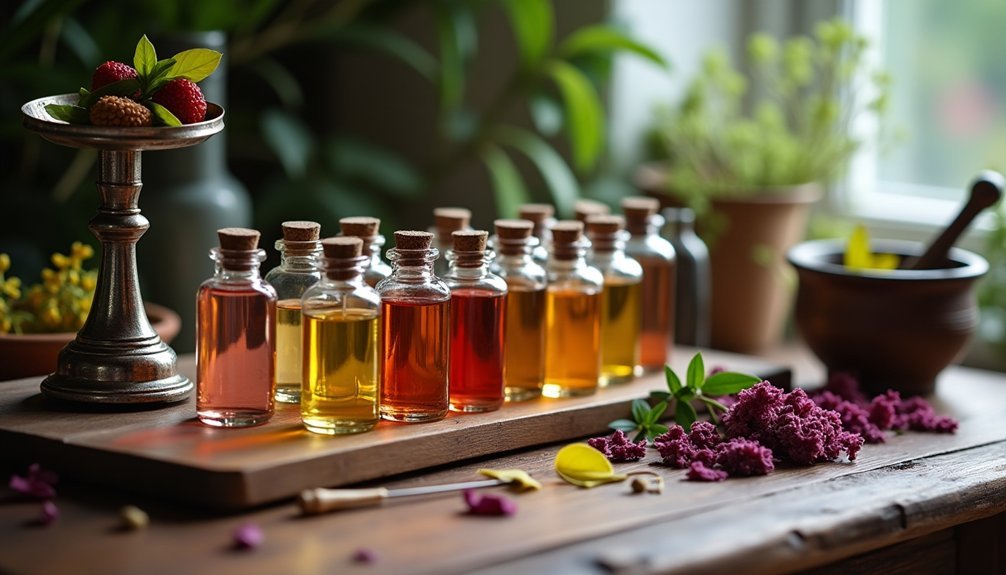



Leave a Reply